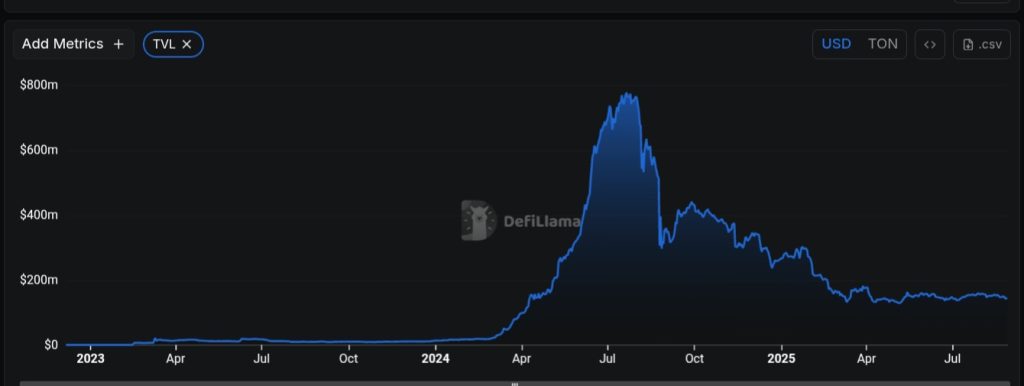Key Takeaways:
- Telegram CEO Pavel Durov has criticized his arrest by the French police last year as “legally and logically absurd.”
- The incident continues to cast a shadow on the TON blockchain, with the native Toncoin cryptocurrency losing 40% of its value since the arrest.
- While TON’s core infrastructure remains stable, user activity (-88%) and developer momentum have slowed sharply.
The arrest of Telegram CEO Pavel Durov last year sent the TON ecosystem reeling. One year later, the case is still unresolved, leaving the Telegram-linked blockchain project The Open Network (TON) in limbo.
Durov was arrested at a Paris airport on August 24, 2024, under a warrant related to the Telegram messaging app. The 40-year-old billionaire faces multiple charges in France, including claims of weak content moderation.
Durov spent four days behind bars before posting €5 million bail. Earlier this week, the Russian-born tech entrepreneur, who is known for his focus on privacy, criticized his arrest as “legally and logically absurd.”
“Arresting a CEO of a major platform over the actions of its users was not only unprecedented — it was legally and logically absurd,” Durov said.
Durov said the French “criminal investigation is struggling to find anything that I or Telegram did wrong.” He claimed that Telegram always complied with legally binding requests from French authorities.
“Ironically,” Durov added, “I was arrested due to the French police’s own mistake: before August 2024, they ignored French and EU laws and hadn’t sent any of their queries to Telegram via the required legal process. They could have learned the correct procedure simply by googling it or asking.”
Since his release on bail, Durov has remained under judicial supervision and is required to check in with the French police every 14 days. He says the case has so far accomplished little beyond “massive damage to France’s image as a free country.”
Shock to the TON Ecosystem
Durov’s arrest did not just rattle European privacy debates. It also sparked a crisis for the TON blockchain, a project originally incubated by Telegram and later handed to the open-source community under TON Foundation.
TON had been gaining traction in 2024 as a hub for decentralized finance (DeFi) platforms and so-called “tap-to-earn” games — like Hamster Kombat and Catizen — integrated with the roughly one billion Telegram users.
But when news of Durov’s arrest went public, Toncoin, the native token of the TON blockchain, nosedived, losing $2.4 billion of its market value within 48 hours.
“Toncoin’s price slumped by over 20% within a few days of his arrest,” said Shawn Young, chief analyst at crypto exchange MEXC. “The shock didn’t stop there. Over the past year, TON has lost over 40% of its value.”
 24h7d30d1yAll time
24h7d30d1yAll timeThe knock-on effects were severe. Liquidity drained from decentralized exchanges built on TON, such as Ston.fi and Dedust, whose total value locked (TVL) plunged by more than 60% in August 2024.
Young noted that while some developers kept building on TON, ambiguity around Durov’s legal situation tampered with developer interest, telling Cryptonews:
“The arrest created a cloud of uncertainty. Developers became cautious, and institutional engagement cooled off. The current pace of deployment and new project launches is below the levels expected for a blockchain of TON’s scale.”
Meanwhile, the total value locked in the TON network has plummeted 71% to $144 million since Durov’s arrest one year ago, per Defillama data. TVL is a measure of user activity and adoption in a DeFi protocol.
It is notable that the TON blockchain had already been losing value since hitting a peak of about $770 million in TVL in late July 2024. By the time Durov got arrested, the protocol had lost over $260 million in total value locked.

Illia Otychenko, lead analyst at crypto exchange CEX.io, said the downturn exposed deeper fragilities within the TON ecosystem.
“The arrest caused a short-term volatility shock, but the long-term challenge is TON’s heavy reliance on speculative game mechanics rather than sustainable use cases,” Otychenko told Cryptonews.
A Fragile User Base
In the weeks following Durov’s arrest, user activity on TON spiked — not due to the legal drama, but thanks to viral tap-to-earn games built using Telegram’s “mini apps”, web apps that run inside the messaging platform.
The games enjoyed a huge following. At one time, Hamster Kombat alone claimed to have 300 million users. Players could tap their smartphone screens endlessly for rewards and later trade them for Toncoin.
But enthusiasm declined as rewards failed to meet expectations. “As user interest faded, activity in these games — the main driver of TON engagement in 2024 — quickly collapsed,” said Otychenko.
Daily transactions on TON’s workchains, where nearly all end-user activity takes place, tanked 76%. Daily active users dropped by 88% and monthly app revenue plunged by 80%, according to data from CEX.io exchange.
“[It] highlights that the network has been struggling to generate sustainable income and engagement after the fallout of tap-to-earn games,” Otyechnko detailed.
Even the rate of new adoption slowed dramatically. Last year, up to half of TON’s daily active users were new addresses. Now, that figure is closer to 20–25%.
“This indicates TON is having difficulty bringing in new users and is increasingly dependent on existing participants,” he added.
The masterchain, TON’s validator and governance backbone, remained relatively stable. Daily transactions rose from 80,000 to 100,000 while active users fell from 900 to 800.
Otychenko said the “modest decline points to cooling builder momentum but not structural instability.” However, for a network pitched as the next global blockchain, momentum appears to have stalled.
Privacy vs. Regulation
Durov’s arrest shook the tech world: if Telegram’s CEO could be detained for crimes committed by users, no social media boss was safe. X (Twitter) owner Elon Musk promptly denounced the arrest as an attack on free speech.
Facebook CEO Mark Zuckerberg wrote a letter to the U.S House Judiciary Committee regretting the firm’s decision to censor content considered by the Biden Administration as misinformation during the pandemic.
At its core, the Telegram founder’s arrest highlights the tension between privacy and law enforcement. Governments are worried that social media is becoming too powerful in shaping public opinion, analysts say.
On the other hand, Durov has long promoted Telegram as a haven for secure communications, resisting pressure from governments to weaken its encryption or share user data.
According to its website, Telegram’s servers are spread worldwide. As a result, the platform “can ensure that no single government or block of like-minded countries can intrude on people’s privacy and freedom of expression,” the company explains.
However, the messaging app has often found itself in the crosshairs of regulators over its laid-back content moderation policies.
For example, in 2023, Brazil temporarily banned Telegram after it refused to disclose the data allegedly linked to neo-Nazi groups after violent attacks on schools.
In 2014, a year after creating Telegram, Durov was forced to leave Russia after the Federal Security Service (FSB) reportedly pressured him to sell his shareholding in the platform. A Moscow court later banned Telegram after it refused to share encryption keys with the secret service.
Today, Telegram is one of the most widely used social media platforms in Russia. The military uses the service to communicate the war effort, while civilians rely on it for unfiltered news coverage.
In France, Durov was charged with several crimes, including complicity in drug trafficking, dissemination of child pornography, fraud, money laundering, and illegal provision of cryptographic services.
TON Market Sentiment Still in the Balance
The legal uncertainty has proven as damaging as any technical shortfall for Toncoin investors.
“In markets [that are] as sentiment-driven as the crypto space, regulatory ambiguity alone can be a heavier drag than technical challenges,” said Young, the MEXC analyst.
Institutional players, whose involvement is crucial for scaling the TON blockchain beyond niche Telegram integrations, have largely taken a “wait and see” approach. Retail investors also remain cautious.
“The fundamentals of TON remain strong and unfettered: integration with Telegram, privacy-first approach,” Young said, adding:
“Until there’s further clarity on Durov’s case, TON’s adoption and price are likely to remain constrained…”
CEX.io exchange’s Otyechnko said while the arrest deepened the decline in the price of Toncoin, the bigger issue lies in ecosystem development — whether the developers can build sustainable apps apart from games and airdrops.
“TON’s backbone remains stable, but its user-facing layer is fragile. Without new growth drivers, the network risks stagnation despite its resilience at the protocol level.”
For Durov, the case is about more than just personal freedom or market sentiment. It is about principle. “The only outcome of my arrest so far has been massive damage to France’s image as a free country,” he wrote on his Telegram channel.
The post One Year On: Telegram’s Privacy Battle With France Stalls, Leaving TON in Limbo appeared first on Cryptonews.

